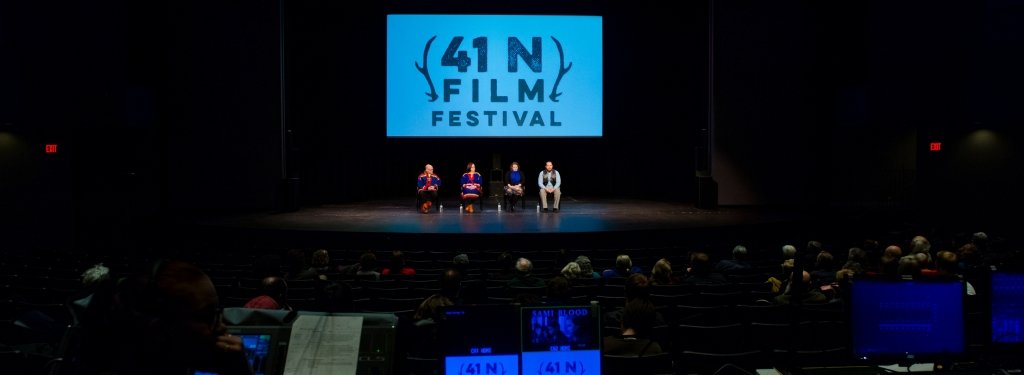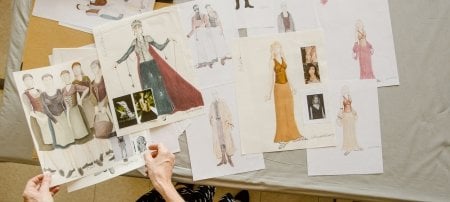In her latest book, Diane Shoos examines portrayals of abusive relationships on the Silver Screen that reinforce who and what we believe about domestic violence.
In late 2014, released security footage from an Atlantic City casino showed a professional athlete striking his then-fiancé in the face, rendering her unconscious. The woman in the video—who had since married the athlete—was criticized for remaining in an abusive relationship. As part of the discussion, the hashtag #WhyIStayed trended nationally on Twitter.
But within a matter of weeks, people had moved on.
“Public discussion of domestic violence has been very sporadic,” says Diane Shoos, an associate professor of visual studies at Michigan Technological University. “Whenever there’s a media event or a new film that broaches the topic, we talk about it, but the conversation usually quiets down pretty quickly. I wanted to take a deeper look.”
To get that deeper look, Shoos studied a body of Hollywood films that focus on male partner violence against women, rather than use it as a backstory or subplot. “One of the reasons I chose Hollywood films is because of their accessibility and their ubiquity—they have a large audience that spans the world. I was interested in the way these films might shape our viewpoints on domestic violence as a social problem.”
Shoos found that even though these films intend to condemn abuse and empower women, they ignore the complexities and consequences of violent relationships.
What We Witness
Shoos’ professional expertise is in gender and film. She also served for 18 years as a board member, and for several years as board chair, for Barbara Kettle Gundlach Shelter Home, a refuge for domestic violence victims and their children.
“I saw again and again that representation in film and television was far from what was really happening to abused women,” Shoos says, “and I wanted to talk about the reasons for and consequences of that gap.”
In Domestic Violence in Hollywood Film: Gaslighting, Shoos argues that what we see onscreen has a significant impact on what we believe about domestic violence, mainly because domestic violence typically happens behind closed doors.
“There is a certain level of denial about it, and there's a way in which we as a society turn to abused women to explain domestic violence—what did they do to cause it or why didn’t they leave,” Shoos says. “I thought it was really important to look at these films because all cultural representation will have an influence on us, but especially so if it's an issue we don't experience or experience secondhand—maybe we know somebody or have someone in our family who’s been abused. But it isn't something that happens publicly or is talked about openly. It is still an uncomfortable topic.”
Shoos examines six films—Gaslight (1944), Sleeping with the Enemy (1991), What’s Love Got To Do With It (1993), Dolores Claiborne (1995), Enough (2002) and Safe Haven (2013). While she thinks each contains positive elements, “there are certain characterizations and narrative patterns in these films that have become so established and ingrained that we seem to be stuck with them, inside and outside the theater.”
Narrative and Genre
When Shoos refers to "Hollywood films," she specifically means popular U.S. cinema—movies that are intended to bring in large audiences and make a profit.
“There are proven formulas,” she says, “that work to draw audiences in. Two examples are the suspense-thriller genre and the action genre. Of course, there are positives to those genres because they do bring people to the theater. Someone who may never go see a film about domestic violence might go to an action film starring Jennifer Lopez.”
In the 2002 film Enough, Lopez stars as Slim, a waitress who falls in love with, marries and has a child with wealthy Mitch. Over time, the marriage deteriorates—Mitch strikes Slim during an argument. When the abuse continues to escalate, Slim takes her daughter and runs away. Mitch tracks her down, and Slim is unable to get help from outside sources like the police and lawyers. When Mitch threatens to get legal custody of their daughter, Slim is forced to take matters into her own hands, training relentlessly in martial arts until the final scene, where she confronts Mitch, engages him in a physical fight and ultimately kills him.
Even though the film takes the side of the abused woman, Shoos points out that it portrays an unrealistic and dangerous form of victim empowerment that involves running away and changing one's identity before ultimately standing up to the abuser.
"It’s a hyperbolic notion of feminine agency that is very predictable at this point, and the narrative closure is usually the death of the abuser by the abused woman. Not only do women do away with their abusers in these films, they get away with it, which is totally misrepresentative and gives no accounting of what really happens to abused women who kill."
Shoos comments that parts of this storyline erode the cornerstones of the campaign against domestic violence: abuse is not your fault, you don’t have to deal with it alone and resources are available to help you leave dangerous situations.
“Most of these films acknowledge that there are shelters, hotlines and personal protection orders,” Shoos says, “but then make a point of showing that these resources are not only inadequate, they are total failures. This throws everything back onto the woman’s shoulders. She is completely isolated, and then the narrative drives toward a confrontation between her and her abuser.
“The problem with that is abused women rarely seek out these confrontations,” she continues. “They are trying to understand and cope with the man's behavior and maintain the love relationship, and mostly they're trying to make the violence stop. Sometimes they have to get away to do that. But anyone who's worked in domestic violence knows that revenge is not a primary motivation for abused women—they want to have a safe life and they want to have a love relationship that's not violent and threatening to them and their children.”
Gaps in the Plot Line
Shoos notes that the majority of Hollywood films about domestic violence center on middle- and upper-middle-class white women with the resources to escape. This reinforces the idea that it’s relatively easy for a woman to leave an abusive relationship—she just has to decide to do so.
"One of the big absences is the lack of any attention to abuse suffered by poor women and women of color,” says Shoos. “We don't take into account enough how race, class, education and other factors intersect when it comes to domestic violence. For example, the way in which an abuser might act out—his strategies—are very different depending on his social identity and situation.”
One exception is What’s Love Got to Do with It, the biopic that tells the story of Tina Turner’s rise to fame and her relationship with her abusive husband Ike Turner. Yet while the movie shows the abuse experienced by a woman of color, Shoos notes that it centers on a celebrity. She comments that while it’s untrue and unfair to imply that abuse happens only to ”others,” it’s just as damaging to ignore the experiences of non-white and working-class women.

Shoos also sees problems with the depiction of perpetrators. “Abusers are portrayed in these movies as absolute monsters, even if they look normal in the beginning. This reinforces the idea that abusive behavior is identifiable and obvious—it lets us stand outside the relationship and say it’s so easy to see what’s happening and what the woman should do. But just because someone appears to be a likeable person, a wonderful father, a professional, someone who is respected in the community, does not mean they are not abusing their partner. We need to learn this lesson, as well as the lesson that psychological and emotional abuse rather than physical abuse are the main forms of domestic violence.”
Even though it is the oldest film on her list, Shoos says Gaslight does the best job of portraying psychological abuse—strategies the husband uses on his wife to discredit her and make her question her own reality. “We should absolutely be concerned about physical violence, but that isn't the primary form of abuse,” Shoos says. “Often, long after physical abuse may have stopped, the control that abusers exert over women may still be present.”
Opening Closed Doors
Shoos sees some positive aspects of each Hollywood film she analyzes. For instance, in Sleeping with the Enemy—the 1991 blockbuster that depicted an abused Julia Roberts ultimately killing her deranged, abusive husband—viewers witness the husband’s micro-regulation of his wife’s behavior, right down to how the hand towels are aligned, and understand how she feels trapped in her own home. Scenes in Enough and What’s Love help the viewer understand how motherhood can be used to manipulate an abused woman.
"There are ways in which genre formulas have brought this issue to the screen, and that's important, but at the end of the day, visibility for domestic violence is not enough. The question is what kind of visibility it has."
"If popular versions of domestic violence narratives keep on following these very predictable and very fantastical formulas that are farther and farther away from lived experiences and the actual repercussions of domestic violence, what are they really accomplishing?" Shoos asks. "Their ability to empower or even inspire abused women or to motivate us to be advocates for them is minimal.”
Shoos says the point of her analysis was not to find or promote an “ideal film” about domestic violence, but to demonstrate the need for more representations of domestic violence that show the complexity of these relationships.
“The more different kinds of stories that are out there, especially stories that show the agency of abused women even within their abusive relationships, the better. Women cope, they understand, they know the limits, they know the risks much better than anybody outside their relationship can,” Shoos says. “I think we still tend to think of abused women as somehow not as smart or strong, when in fact anyone can end up in an abusive relationship, and anybody does. To not take seriously the perspectives of people who have been in those situations, to not look at them as the experts about what they should or shouldn't be doing at any particular time is a huge mistake.”
Shoos finds encouragement in the growth of independent cinema and new media outlets that are “fostering and giving space to narratives that tell unexpected stories of men and women whom we may not immediately recognize as perpetrators and victim/survivors of abuse.”
She specifically mentions Big Little Lies, an HBO miniseries that was released just a few months before her book went to print. While Big Little Lies follows some of the typical narratives—it focuses on white women in the wealthy California community of Monterey—Shoos says the stories themselves go against preconceived ideas about abusers and abused women, demonstrate the effects of abuse on children and show various forms of psychological abuse.
Since its release, Big Little Lies has won the Emmy for Outstanding Limited Series and a Golden Globe for Best Miniseries or Television Film. In her acceptance speech at the Golden Globes, miniseries executive producer and star Reese Witherspoon, wearing black in support of the #metoo and #timesup social media campaigns that call for an end to sexual abuse in all forms, said the show is about how the life “we present to the world could be very different than the life we live behind closed doors.” She expressed the hope that more shows like Big Little Lies will be made that tell the stories of people who have been silenced by harassment, discrimination, and abuse.
Media Literacy
Shoos ends her book with a similar plea for more representations and also for critical viewing.
“Media literacy is not just watching a bunch of stuff. We're not all media literate because we binge watch,” Shoos says. “Media literacy is taking a look at what’s happening on screen and analyzing it on multiple levels. Let's understand how narrative and cinematic techniques are being used, which characters are given a voice and which characters are not, where there are mixed messages and contradictions. And how does this overlap with other discussions we're having in the world? To say representation matters is not an new observation. But it matters especially in the case of domestic violence.”
Michigan Technological University is an R1 public research university founded in 1885 in Houghton, and is home to nearly 7,500 students from more than 60 countries around the world. Consistently ranked among the best universities in the country for return on investment, Michigan's flagship technological university offers more than 185 undergraduate and graduate degree programs in science and technology, engineering, computing, forestry, business, health professions, humanities, mathematics, social sciences, and the arts. The rural campus is situated just miles from Lake Superior in Michigan's Upper Peninsula, offering year-round opportunities for outdoor adventure.






Comments